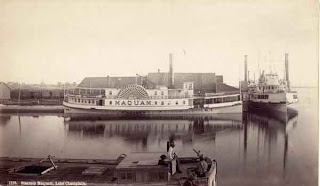 The Adirondack Museum has announced a new exhibit, A ‘-Wild, Unsettled Country’: Early Reflections of the Adirondacks, that will look at the early efforts to convey the Adirondacks visually to the wider world. The exhibit will open on May 22, 2009 – meaning that year-round Adirondack Park residents should be able to catch the exhibit for free the last week of May.
The Adirondack Museum has announced a new exhibit, A ‘-Wild, Unsettled Country’: Early Reflections of the Adirondacks, that will look at the early efforts to convey the Adirondacks visually to the wider world. The exhibit will open on May 22, 2009 – meaning that year-round Adirondack Park residents should be able to catch the exhibit for free the last week of May.
The first Europeans to see the Adirondack landscape of northern New York State came to explore, to document important military operations and fortifications, or to create maps and scientifically accurate images of the terrain, flora, and fauna.
These early illustrations filled practical needs rather than aesthetic ones.
The exhibition will showcase approximately forty paintings from the museum’s exceptional art collection, including works by Thomas Cole, John Frederick Kensett, William Havell, John Henry Dolph and James David Smillie.
Also featured are fifty of the engravings and lithographs of Adirondack landscape paintings that brought these images to a wider audience and provided many Americans with their first glimpse of the “howling wilds” that were the Adirondack Mountains.
While tourists were flocking to Saratoga Springs, N.Y. in the 1830s, few ventured north into the “lofty chain of granite” visible from Lake George. One guidebook described the mysterious forms as “a wild repulsive aspect.” Little was known of these yet-unnamed mountains.
In 1836, the New York State legislature authorized a survey of the state’s natural resources. Artist Charles Cromwell Ingham was asked to join geologists Ebenezer Emmons and William C. Redfield during one of the first exploratory surveys. During the trip, he painted The Great Adirondack Pass, “on the spot.” The original painting will be shown in the exhibition.
The exhibit will also include photographs-stereo views and albumen prints-sold as tourist souvenirs and to armchair travelers. William James Stillman took the earliest photos in the exhibition in 1859. These rare images are the first photographic landscape studies taken in the Adirondacks. Photos by Seneca Ray Stoddard will also be displayed.
Significant historic maps will illustrate the growth of knowledge about the Adirondack region. In 1818, it was still a mysterious “wild, barren tract…-covered with almost impenetrable Bogs, Marshes & Ponds, and the uplands with Rocks and evergreens.” By 1870, the Adirondacks had become a tourist destination with clearly defined travel routes, hotels, beaches, and camps.
“A ‘-Wild, Unsettled Country’” will be on exhibit in the Lynn H. Boillot Art Galleries. The space includes the Adirondack Museum Gallery Study Center – a resource for learning more about American art. In addition to a library of reference books, a touch screen computer allows visitors to access images from the museum’s extensive fine art collection.
The Gallery Study Center will include a media space as part of the special exhibit. The documentary film “Champlain: The Lake Between” will be shown continuously. The film, part of the Lake Champlain Voyages of Discovery project, has aired on Vermont Public Television in recent months.
“A ‘-Wild, Unsettled Country’” is not just for adults. Family-friendly elements include Looking at Art With Children – a guide for parents as they investigate the arts with youngsters- the Grand Tour Guide – a colorful and engaging map that encourages exploration of the Adirondack sites shown in the paintings- and ten different Wild About! guidebooks that urge kids to be “wild” about maps, prints, history, and more.
Photo caption: View of Caldwell, Lake George, by William Tolman Carlton, 1844. Collection of the Adirondack Museum.
 The Clinton-Essex Counties Roundtable will be held from 9:30 a.m. to 1:00 p.m. on Saturday, May 9, 2009 at the Northern New York American Canadian Genealogy Society, Keeseville Civic Center, 1802 Main St., Keeseville. The topic will be “Community Scholars Training: Interviewing & Oral History” and will be presented by Traditional Arts in Upstate New York (TAUNY) Executive Director Jill Breit.
The Clinton-Essex Counties Roundtable will be held from 9:30 a.m. to 1:00 p.m. on Saturday, May 9, 2009 at the Northern New York American Canadian Genealogy Society, Keeseville Civic Center, 1802 Main St., Keeseville. The topic will be “Community Scholars Training: Interviewing & Oral History” and will be presented by Traditional Arts in Upstate New York (TAUNY) Executive Director Jill Breit.






